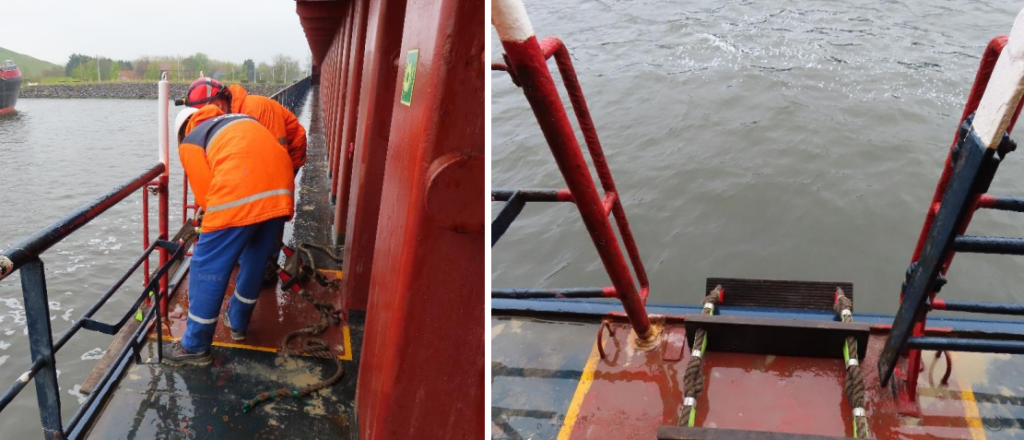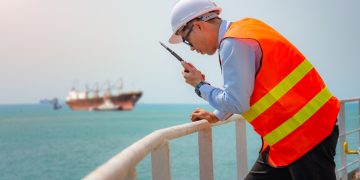The Bahamas Maritime Authority (BMA) has published an investigation report into an incident where a crew member of the Fri Sea fell overboard and later died after rigging a pilot ladder at night.
The incident
At 11:00 on 28 March 2024, the Bahamas-flagged coastal general cargo vessel, Fri Sea, completed discharge of its cargo of sepiolite granules and was ready to depart Groveport, UK on the next tide. At 18:50, the pilot boarded, the master/pilot exchange and pre-departure checks were completed, and at 19:07, the vessel departed in convoy with three other vessels. Soon after clearing the berth, the master asked the pilot which side to rig the pilot ladder. The pilot replied he would not know for some time, so the crew were stood down. The master remained on the bridge with the pilot, who kept the conn.
At 22:10, the pilot reported to Humber Vessel Traffic Services (VTS), who confirmed that the pilot ladder should be rigged on the port side, 1.5 meters above the water. The pilot relayed this to the master, also confirming it would be around 45 minutes until disembarkation.

/Credit: BMA
Shortly afterward, on instruction from the master, two crew members (AB1 & AB2) went on deck to rig the pilot ladder. Having removed it from its stowage position on the cargo hatch level, they lowered it to the main deck on the port side and, after opening the gate in the ship’s rails, they lowered it into position and secured it. At approximately 22:35, AB2 radioed the master to confirm that the ladder was ready. AB1 then returned to the accommodation while AB2 stayed on deck to smoke a cigarette.
Approximately 15 minutes later, the master called AB2 on the handheld radio to say that the pilot was ready to disembark but got no reply. Having called several times, the master went to the messroom and, seeing AB1, asked where AB2 was. At the direction of the master, AB1 then went on deck to check. After a quick search of the vessel, AB1 reported that AB2 could not be found.
At 22:50, the master informed the pilot that they had a potential man overboard, at which point the pilot asked the master to raise the alarm. The pilot then informed Humber VTS and stopped the engines. The whole crew mobilized to keep lookout. No life ring or other marker was deployed.
The pilot boat, which was about to collect the pilot from the vessel ahead, quickly started a search and was joined by multiple air and sea assets, including the Humber lifeboat at 23:58. The search was coordinated by Humber VTS until relieved by Humber Coastguard at 01:47 with datum and likely drift pattern based on the location of the Fri Sea when the alarm was raised and information that the missing person was wearing a lifejacket. The search continued until 08:52 when Humber Coastguard called off the search.
AB2’s body was found at 10:30, washed ashore approximately 13 nautical miles from the position where the alarm was raised. The victim was not wearing a lifejacket.
Conclusions
A post-mortem indicated that the victim died as a result of acute myocardial ischaemia, ischaemic heart disease, and severe coronary artery atheroma. This underlying health condition had not been identified as part of the seafarer’s medical examination.
Nevertheless, the victim was on deck, in the dark and alone, in close proximity to an opening in the ship’s rails with no fall protection or personal flotation device. The crew were regularly exposed to unnecessary risk when rigging or retrieving the pilot ladder – the work was not considered to be “work over the side,” so no controls were in place. There were no lifejackets suitable for work onboard the vessel and no administrative barriers that related to the task.
In line with requirements, the gate in the ship’s rails opened inwards, but its design meant that it had to remain open when the pilot ladder was in place, increasing exposure to risk.
While it would not have had an impact on the outcome of the casualty, providing the pilot (and subsequently Humber VTS) with the incorrect information that the man overboard was wearing a lifejacket had a detrimental impact on the modeling of the search operation. Similarly, using the time and location of the initial report meant that the correct datum was not established for the search.
While it would not have had an impact on the outcome of the casualty, the Humber lifeboat was waiting in the lock at Grimsby for over an hour after mobilizing. Humber lifeboat’s availability may be more restricted than identified on the basis of tidal predictions alone.
Action taken and recommendations
Kopervik Ship Management Poland Sp. z o.o has:
- Provided vessels in its fleet with inflatable lifejackets.
- Reviewed the design of openings in ship’s rails throughout its fleet. The gate on Fri Sea has been altered to allow it to be closed when the pilot ladder is rigged.
- Added anti-slip coating to the decks between the pilot ladder and accommodation.
- Revised its procedure for rigging the pilot ladder (including mandatory use of inflatable lifejackets) and issued a fleet circular explaining the changes.
Considering the actions taken, there are no further recommendations.
































































